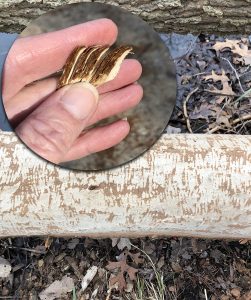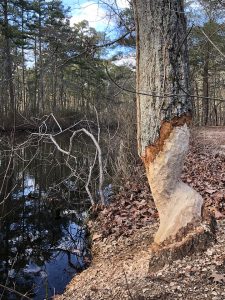Busy Beavers
Their lodge building and eating habits demand the felling of many trees.


In the late 1980s one of my friends took me to meet Hope Sawyer Buyukmihci, the founder of Unexpected Wildlife Refuge in Newfield. There was a peculiar entrance in her living room and I inquired about it. “Oh, that was for Chopper,” she explained.
“Chopper?”
“Yes, Chopper the beaver.”
I guess I had my “For real?” look on my face. So she went on to explain that the reason she initially preserved the property was just to protect the beavers. She and her husband had created a 60-foot subterranean passage so the beaver could safely get from a nearby pond into their house. As background she gave me a copy of a book that she had collaborated on with Dorothy Richards, the “Beaver Lady.” Beavers have a history of having been exploited and persecuted to near extinction, but this was my first encounter with people who had made it their life’s work to protect these animals.
As you likely know, beaver pelts were prized in the 1600s and 1700s. In fact, in what is considered colonial New Sweden, the region settled along the Delaware River by Swedes, 9,000 to 10,000 pelts were traded per season in the mid-1600s. Native Americans exchanged beaver pelts for wampum with the settlers, and in turn settlers exchanged pelts for supplies and services. Beaver fur was in high demand because it was valued for its warmth and waterproof qualities, and was fashioned into hats, coats, blankets, collars and the like.
Beaver meat is said to be tasty and the tail at one time was considered a delicacy. The creatures have a scent gland that produces castoreum, used in medicine, food, and perfumes, the latter being the most common and still in limited use. Castoreum (not to be confused with the castor oil that comes from castor beans) was added to beverages, ice cream, baked goods, and especially bubblegum.
The 1907 report of the New Jersey State Museum notes that New Jersey’s original beavers were the “southern or Carolina Beaver, somewhat lighter and larger than the Northern or Canadian Form”… and that the “last NJ specimens were killed about 1820.” I suspect the southern beaver was a subspecies since there are only two species worldwide of beavers: Castor fiber, a Eurasian species and Castor canadensis, the American beaver.
In 1902 the only beaver activity in New Jersey was in the area of Roseville and Two Bridges in the northern part of the state. By 1903 beavers were listed as protected; they were nearly extirpated in much of their native range. Especially in the Northeast where human population was the greatest, so was their exploitation. In 1934 New Jersey Fish and Game brought in 1,500 beavers from Wisconsin, Michigan, Wyoming, and Minnesota. By 1947 the beavers had re-established their numbers, such that the State once again allowed trapping until the 1960s. Numbers dropped off and it wasn’t until 1970 that trapping was once again permitted. In 1989 the State reported some 200 separate known colonies. By 2015 the estimated statewide population was 10 to 15 million. Over the past 10 years New Jersey trappers have averaged a harvest of 585 beavers each year. Today beavers are present throughout their original range in North America; southern California and most of Nevada do not have any.
Let’s discuss this semi-aquatic animal’s natural history. They are mammals, so they breathe air, drink their mother’s milk, and have fur. North America’s largest rodent, beavers are second in size only to South America’s capybara, which is the largest rodent worldwide. They typically weigh 28 to 60 pounds, and the Smithsonian has reported a record weight of 88 pounds. They are primarily nocturnal and crepuscular—active at dawn, dusk, and through the night.
Beavers’ most defining features are their tail, teeth, and size. The tail is wide, flat, and scaled, used for stability when out of water and sitting upright. In the water it serves as a rudder and for some propulsion. Beavers also slap their tail to ward off intruders or signal a warning. Its fatty layer is used for insulation. Animals who hunt beavers include wolves, fishers, bear, owls, eagles, and coyotes, while the otter is the most common. The juveniles are the primary target; once fully grown their size is a deterrent to predation. Their best defense is to retreat to water where they can elude danger more easily by swimming and submerging. By far their greatest threat comes from humans.

The beaver’s short front legs are used for carrying sticks or pushing logs, for both consumption and construction of a lodge. The back legs with webbed feet and their body orifices are adapted to their aquatic lifestyle. Nostrils, ears, and a flap of skin in their mouths close shut to prevent water from seeping in. Beavers can carry a branch in their mouth and the flap of skin will still keep out the water.
Their eyes have a clear thin lid called a nictitating membrane that can be closed to help protect them when doing work in the water. Many vertebrate species have nictitating membranes, including amphibians, reptiles, birds, and some mammals; however apes and humans do not. Beavers are awkward on land, but in the water they can swim up to six miles per hour. Amazingly they can stay submerged for up to 15 minutes, allowing them to travel over half a mile underwater.
Their back webbed foot has a double toenail on the second toe that is used for grooming. The beaver’s coat is made of two distinct fur layers—a soft undercoat and a coarse sparse upper coat made up of “guard-hairs.” Their tooth enamel is orange-colored and contains iron. These choppers, coupled with powerful jaws, are used for gnawing, feeding, and transporting wood items.
The castor sacs are scent glands that are present in both male and female beavers. They are located at the base of the tail and are used to mark their territory along with urine. Castoreum, the secreted yellowish liquid, is said to have a distinctive odor similar to vanilla. They often deposit it on mounds of mud. Because they are very territorial, scent marking is a way of marking a colony’s range. Sexually mature at three years, beavers are primarily monogamous but males may mate with more than one female.
Mating occurs from January through March with a gestation period of about three months; they have one litter a year. The average number of kits, their young, is 3.5. When born kits weigh about 1/2 lb. to 1.3 lb. and are about 14 inches long, including their tail. Their eyes are open, they have fur, and within 24 hours they can swim, although they remain in their lodge for about a month. Weaning from their mother’s milk can occur in as short a time as two weeks or as long as 90 days. They make trips out of the lodge as early as a month old but they normally stay with their parents for about two years before moving on to another colony.
Their lodge building and eating habits demand the felling of a lot of trees. They’re particularly fond of eating the cambium layer just beneath the bark of trees. Since beavers are too bottom-heavy to climb, at 23 to 39 inches tall the only way to access the whole length of the tree is to fell it. Their powerful jaws and strong teeth can make quick work of this task. Once the tree is down the beaver eats the surface of the main trunk, much like we eat corn on the cob, gnawing away along its length. In colder climates smaller tree limbs are removed in autumn, taken to the foot of dams, and speared into the mud for winter retrieval, especially where waters freeze.
Beavers are builders and to a large extent they create their own habitat. The dams they build block the flow of streams, although sometimes they simply make a bank-style lodge or island. Their dams can control the flow of water and prevent erosion, but they can also cause flooding upstream that may conflict with roads or people’s dwellings. Also, a flooded stream plain often kills forests. The stands of dead trees can become habitat for tree-nesting birds like owls, woodpeckers, osprey, ducks and others. When, or if, the dam is later derelict or abandoned, waters recede leaving a riverine meadow. This creates habitat for a host of other species like pollinators, shrews, voles, fox, nesting ducks and other birds, rabbits, and browsing animals.
Dammed areas also trap sediments and promote the growth of aquatic vegetation. This wetland vegetation then cleans the pollutants in these sediments. In some cases the trapped sediments also form meadows by filling in the streambed’s sides.
Above the dam beavers build canals that serve many purposes. Each one gives them the ability to float limbs back to the lodge for building or food storage. These channels also provide access to trees that are further from the streambank, as well as quick getaway routes from non-aquatic predators.
Vegetation and cambium are major components of their diet, yet most mammals can’t digest cellulose. However, beavers have a sac between their large and small intestine containing microorganisms that allow them to break down the cellulose components. Contrary to common belief they do not eat fish; they are strictly vegetarians.
Beavers are beneficial members of the ecosystem and play an important role in habitat development; a single beaver can cut down as many as 200 trees a year. However, with all the gnawing and tree damage they often come into conflict with property owners. When areas flood this can obviously create serious problems for humans.
Sadly, Chopper was reported by Hope to have been killed by a fisherman’s paddle in front of a group of Girl Scouts. Chopper’s intentions were apparently misunderstood as hostile. I would suspect that most wild beavers that had not been brought into a house and tamed by humans would not have had “intentions” at all, but would simply dive and swim away. Beavers are normally shy unless they are rabid or you continue to advance on them. They have been known to be aggressive with dogs as dogs are often relentless. So besides being illegal, it is clear that leaving wildlife “wild” is kinder than befriending it!
Since that first introduction to beavers I have seen videos taken by wildlife rehabilitators (required to be educated and licensed in most states, including NJ) who have nursed these animals back to health in their houses. So do I recommend keeping a beaver in your home? Allow me to say that while they are amusing, they are clearly not a recommended pet—that is, if you value your belongings. One rehabilitated beaver, cleverly named Justin Beaver, moves all available items around the rehab-er’s house in order to make lodges. And all available wooden items are considered a food source, or rodent dentistry fodder—chairs, tables, all are fair game.
Remember that rodents have to keep their continually growing teeth in check by gnawing. So I surely don’t recommend beavers as cohabitants, not only due to the challenges they present but also because it is illegal. And although beavers can have the tendency to come into cultural conflict with humans, they are an important part of our natural history. The bigger question is, will we allow them thrive in their own home?
Sources:
New Jersey Wildlife Profiles, Beaver, NJ DEP, Patty McConnell
NJ Fish and Wildlife Website
NJ Trapper Survey Results and Harvest Data, NJ Fish and Wildlife, DEP
Animal Diversity Website
Report of NJ State Museum 1907
National Audubon Society Field Guide








